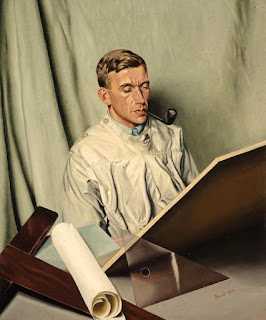George Fairweather was a Scottish architect.
Fairweather was born on 14 July 1906, the son of George Fairweather, a furnituremaker who lived and worked at The Vyne, Dundee. He spent part of his childhood in South Africa but had returned to Dundee by 1922 when he commenced his studies at Dundee School of Art. In July the following year he entered the office of Maclaren Soutar & Salmond as an apprentice, leaving them in August 1927 to spend the final year of his apprenticeship with Mills & Shepherd.
In 1928 or 1929 he came to London to seek further opportunities, and secured a position in the office of Joseph Emberton by sitting at the bottom of the entrance steps every day until Emberton took him on 'if only so that he didn't have to keep walking past me', as he once said. He was one of only two salaried assistants in the office, and when the economic depression hit Emberton's workload, Fairweather volunteered to leave because he was unmarried and therefore without dependents. He was homeless for a time, sleeping on the Embankment, but found employment as a draughtsman with Constantine & Vernon in 1930. The following year he moved to the office of W A Lewis & Partners, and in 1931 returned to Dundee to join the City Architect's Department there. He was admitted ARIBA in early 1932, his proposers being Charles Geddes Soutar, William Salmond and John Donald Mills. His travels for study purposes prior to that time had been limited to two weeks in Southern Germany.
After only eight months in Dundee City Architect's Department, Fairweather left to commence practice on his own account at 49 High Street, Montrose. His practice was almost entirely limited to extensions, alterations and renovations of domestic and farm buildings, his only more substantial works at that time being two houses in St Andrews and a small concert hall for Montrose Town Council. He abandoned his practice in 1935 to join the staff of Sir Walter Tapper as prospective junior partner, but left in 1936 having decided to concentrate on teaching. In that year he ran the Architecture Department of the Bromley School of Art, carried out research into heating of low-cost housing for the Housing Centre, and secured a teaching position in the Architectural Association School, where he later became Senior Master in Construction and Lecturer of Building Construction. He continued to pursue a limited private practice, winning the Industrial Housing Competition in partnership with Miss J Ledeboer and carrying out a certain amount of work in collaboration with Robert Furneaux Jordan and Cecil Handisyde. He also assisted his friend, the sculptor William Lamb, in the design of his studio in Market Street, Montrose.
He contributed articles to a number of journals including the 'Architects' Journal', and a series on Structural Economy for the 'Architect & Building News', which was later published as a book. He was admitted FRIBA on 15 December 1942, his proposers being G A Jellicoe, Charles Lovett Gill and John Grey.
Fairweather's post-war practice played a significant part in the development of modern school design. Fairweather himself was courageous in his opinions, quietly persuasive, and often ran against the grain, buying and refurbishing the vicarage in St Anne's Close, North London in 1949 when such moves were unfashionable, and speaking out against the proposed merger between the Architectural Association Schools and Imperial College in the early 1960s, as well as voicing early concerns about the potential risks of high-rise system building ('One day, one of those blocks will collapse'). He was elected FRIAS in 1965.
He died in Montrose on 13 July 1985.


No comments:
Post a Comment